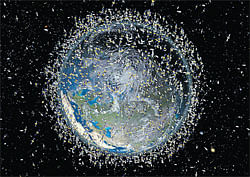Faced with increasing threats of space debris, the US National Aeronautics and Space Administration (Nasa) is actively exploring ways to clean up the outer space.

Donald Kessler, an astrophysicist at Nasa’s Environmental Effects Office, said the space industry has been slowly developing ideas for over 30 years on how to proceed to clean up space junk, but none has ever been fully tested.
Space debris comes from asteroids, comets, meteorites and also defunct man-made space devices or their parts.
“Dead” satellites are an example of space debris, which poses increasing risks to functional satellites and the International Space Station.
Kessler, the first chief of NASA’s Orbital Debris Program Office, said there are three fundamental issues to be resolved in relation to the cleaning up of space junk.
“One, how do we get to the objects inexpensively? Two, how do we grab an object that is likely spinning and not designed to be grabbed? Three, what do we do with the object after grabbing it,” Kessler told Xinhua. Another factor to consider is that astrophysicists and scientists have been slow to address the topic.
To cite a case, Nasa does not annually spend any government funds with regard to the research and the cleaning up of space junk.
Size of space debris can be as small as one centimetre. Astrophysicists and scientists have difficulty putting precise definitions to “large” space debris. However, usually an object of 10 centimetres or greater is considered “large”.
International interest in cleaning up space debris has increased in recent years, especially since February 2009, when two artificial satellites collided at almost about 790 km over Siberia, creating over 1,000 pieces of space debris.
Kessler believes that an increasing frequency of collision of space junk will create “a permanent belt of space debris” that would be so thick that it would be a hazard to any attempted launched rocket or satellite. Two current possible ideas for cleaning up space debris are the use of powerful lasers, whose projected laser beams would push the space junk into lower orbits to be burnt up, and the creation of a matrix of nets to catch some of the space junk.
Kessler, however, thinks that neither concept would be a total solution, even if they worked as planned. Numerous companies in North America are working on various space junk clean-up projects.
One such company is the Star Technology and Research (Star) in Mount Pleasant, South Carolina.
STAR is the recent recipient of nearly $2 million from Nasa to create a spacecraft called ElctroDynamic Debris Eliminator (EDDE).
If successfully made and operated, EDDE would target non-functioning orbiting satellites that weigh one tonne apiece.
“EDDE will ‘sail’ on the Earth’s magnetic field like a sailing ship in the wind, giving it unlimited range, using solar power. This is the breakthrough technology that makes possible the removal of all large, dangerous debris objects in low Earth orbit. We are working to develop the components that make EDDE possible,” Star spokesperson Jerome Pearson said.
Deccan Herald is on WhatsApp Channels| Join now for Breaking News & Editor's Picks